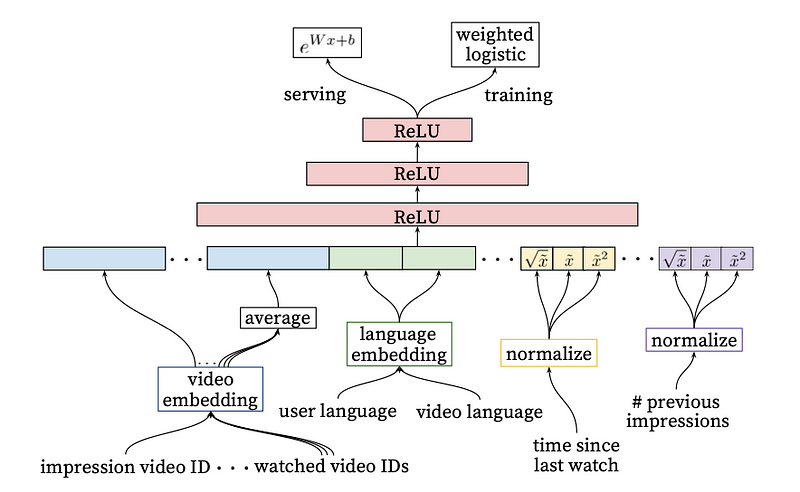Unpacking YouTube's Recommendation System: Key Insights Explained
Written on
Introduction to YouTube’s Recommendation Algorithm
Recommender systems have become an integral part of many industries, particularly in machine learning applications. However, details on their practical operations often remain underexplored. A notable exception is Paul Covington’s influential paper, "Deep Neural Networks for YouTube Recommendations," which provides valuable insights into YouTube’s deep learning-based recommendation algorithm. This paper offers a rare glimpse into the complexities of modern recommender systems and the challenges faced by machine learning engineers today.
If you're interested in enhancing your understanding of these systems, preparing for machine learning design interviews, or are simply curious about YouTube's engagement strategies, continue reading. This article will outline eight essential insights from Covington's work that shed light on the success of YouTube's recommendation system.
Key Insight 1: The Two-Stage Recommendation Process
YouTube's recommendation system operates in two main phases: candidate generation and ranking. The first phase filters billions of videos down to a manageable few hundred, while the second phase sorts these candidates to deliver the most relevant options to the user.
Both phases utilize a two-tower neural network architecture, designed to handle user IDs and video IDs separately. However, their training goals differ significantly: the candidate generation phase is treated as an extreme multi-class classification problem, where the objective is to predict user engagement among existing videos. In contrast, the ranking phase uses a (weighted) logistic regression approach to assess whether a user will engage with a given video.
This dual approach allows the system to optimize for recall in the candidate generation phase—ensuring all relevant content is included—while focusing on precision in the ranking phase—ensuring the best content is prioritized. This methodology is crucial for managing recommendations at the scale of billions of users and videos.

Key Insight 2: Implicit Feedback Over Explicit
Explicit user feedback, such as Likes or Comments, is scarce; only a small portion of viewers engage this way. Training a model solely on such explicit signals would result in significant loss of valuable data. Conversely, implicit feedback—such as clicks and watch duration—is much more abundant, albeit noisier. In YouTube's case, the quantity of implicit data outweighs the quality concerns, making it a more effective training objective.
Key Insight 3: The Importance of Watch Sequence
The order in which users watch videos reveals distinct patterns and asymmetric co-viewing probabilities. For instance, after viewing two videos from the same creator, users are likely to continue with additional content from that creator. A model that ignores this watch history fails to leverage critical information.
Instead, YouTube's model is designed to predict the next video a user will watch based on their most recent activity. This is achieved by incorporating the latest 50 viewed videos and 50 search queries into the model's features.
Key Insight 4: Weighted Logistic Regression for Ranking
In the ranking phase, positive examples (impressions with clicks) are weighted according to the time users spent watching, while negative examples (impressions without clicks) receive uniform weights. This strategy diminishes the influence of clickbait content, favoring videos that foster longer engagement.
The predicted odds from this weighted logistic regression model can be converted into expected watch time, enhancing the system's ability to provide meaningful recommendations.
The first video, "How does YouTube recommend videos? - AI EXPLAINED!" dives into the intricacies of YouTube's recommendation engine, providing a clear overview of its functionality.
Key Insight 5: Ranking by Predicted Watch Time
Ranking content based on predicted watch time is more effective than relying on click-through rates. While the latter may encourage clickbait with low watch durations, the former prioritizes engaging content.
Key Insight 6: Feature Diversity Enhances Performance
The strength of deep learning lies in its ability to manage a wide range of input signals. YouTube’s model analyzes:
- User watch history
- Recent search activity
- Demographic data, including age, gender, location, and device type, which helps with "cold-start" scenarios.
This diversity in features significantly boosts model performance, as demonstrated by an increase in holdout MAP from 6% to 13% when all features are utilized.

Key Insight 7: Fresh Content Through "Example Age" Feature
Machine learning systems often reflect historical biases due to reliance on past data. YouTube addresses this by incorporating the "example age" feature, which helps prioritize newer content during predictions.
This adjustment significantly increases the model's preference for fresh uploads, aligning with user preferences.
Key Insight 8: Efficient Handling of Sparse Features
YouTube's ranking model incorporates numerous high-cardinality categorical features, such as video IDs and user IDs. These features are one-hot encoded and transformed into 32-dimensional embeddings, optimizing memory and training efficiency.
By sharing embeddings across similar features, the model benefits from reduced memory requirements, faster training, and improved generalization.
Coda: The Toolkit of Modern Machine Learning
In conclusion, YouTube's recommendation system is a compilation of various techniques, each addressing specific challenges. From its two-stage funnel design to the incorporation of implicit feedback, these strategies collectively enhance user engagement.
It's essential to recognize that these methods are continually evolving as new advancements emerge in the field of machine learning. The best machine learning engineers are those who continually refine their toolkit, adapting to new insights and challenges.
To delve deeper into the world of machine learning and expand your knowledge, consider exploring resources like my e-book, "Machine Learning on the Ground: Design and Operations of Real-World ML Applications."
The second video titled "The Entire History of the YouTube Algorithm" offers a comprehensive overview of how YouTube's algorithms have developed over time, providing context for today's systems.